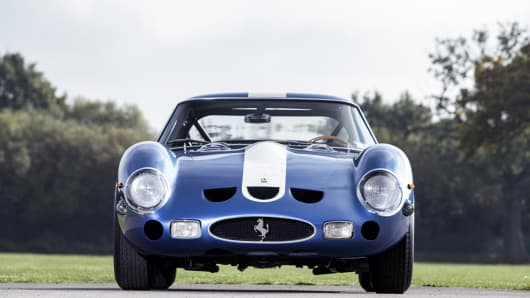Extremely rare? Check. Functional? Check. Envy-inducing? Very probable. If you're searching for the ultimate holiday gift, this 1962 Ferrari may be just the ticket – provided you have a spare $55 million to match the asking price.
This eye-watering sum vastly exceeds the current world record auction price of $38.1 million paid in 2014 for a red version (formerly belonging to British racing legend Stirling Moss) of the same 250 GTO model.
Yet according to John Collins, founder of U.K.-based Ferrari dealer Talacrest, which is selling the car, the less commonplace color of this model should make a difference to the price.
"The color's striking, the blue with a white stripe - it's original race colors and the race history on the car is really good," he explained.
"Most of the GTOs are red - if you compare this with a red one it just stands out so much more," he added.
Furthermore, the car's track record is replete with highlights. This provenance is crucial in today's slowing classic car market where increasingly discerning buyers expect the vehicles, their history and the accompanying documentation of it to be flawless.
As the second of only 39 250 GTOs ever produced, this car was the first of its type to compete in a race and succeeded in notching up 17 class podiums through competition in 27 races.
Strictly speaking, the car shouldn't have even been allowed to compete – according to racing guidelines in place during the 1960s, a production run had to extend to at least 100 examples of a given model to be permitted to race in the Group 3 Grand Tour Car racing bracket.
Ferrari managed to elude these regulations by giving the impression of creating more cars than they actually did by using a non-sequential chassis numbering system– authorities assumed there was a car for each ascending number but in fact there were gaps between the numbers.
"Enzo Ferrari got away with everything," smiled Collins.
And perhaps deservedly so, given that nearly 120 years after his birth, his eponymous brand is still strikingly well-positioned in the industry's aggressive battle for prestige.
‘It’s the curves, the beauty.’
According to Collins, the famed Italian prowess for design beauty is evident in the marque.
"It's the curves, the beauty. There's a big sex appeal of the '50s, you've got all the movie stars buying Ferraris, there's something glamorous about Ferraris," he said.
"But it's not just the glamor, it's also the exceptional racing capabilities," he qualified.
Yet 2016 has been a more challenging year for Ferrari – and indeed the classic car market in general. Data from the industry benchmark (the Historical Auto Group's HAGI index) shows year-to-date growth to the end of November for classic Ferraris is up 3.33 percent. This is the slowest rate of growth for the marque since 2009 and short of the 8.06 percent return for the broader HAGI Top classic car index year to date.
However, over the past five years to the end of November, HAGI's Ferrari-only index has returned 20.50 percent, outpacing the Top index's 19.46 percent.
2017 Demand
Dietrich Hatlapa, founder of the Historical Auto Group, also emphasized rarity as an increasingly important factor in sustaining price momentum in today's climate.
"For Ferrari that means that all models from the late 1970 onwards that have production numbers of 1,000 units or more are less likely to appreciate in value compared to the exceptionally rare, hand-made Ferraris of the 1950s to the early 1970s."
"Ferrari race cars of all decades are most likely to achieve the highest price appreciation," he added.
And looking ahead to 2017?
"Demand is set to continue like in 2016. The question is whether there is an element of oversupply as we have seen this year," Hatlapa noted.
"Much depends on the macro-economic environment – for example, rising interest rates (or expectations) will play an important role. Buyers have become more selective and we expect that to continue in 2017. Focus will be on the highest quality cars in each group (very low mileage, top condition, full documented history) and low production numbers," he explained.





You need to be a member of The Vintage Racing League to add comments!
Join The Vintage Racing League